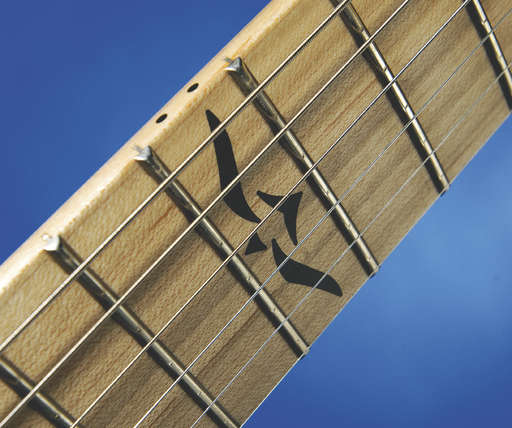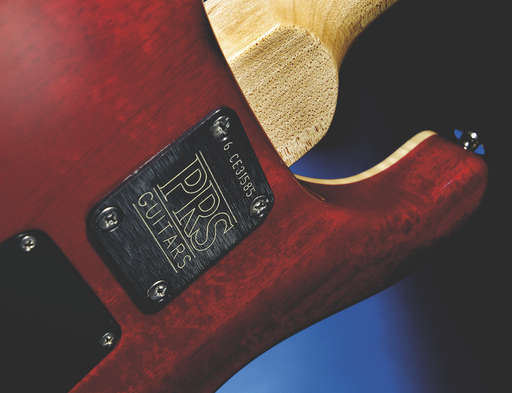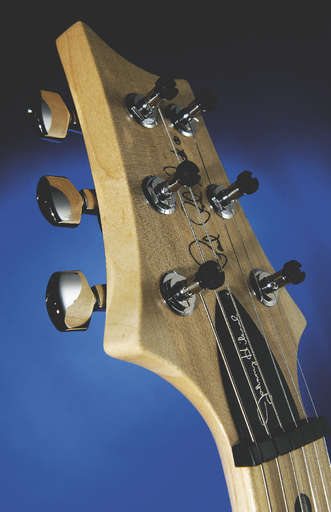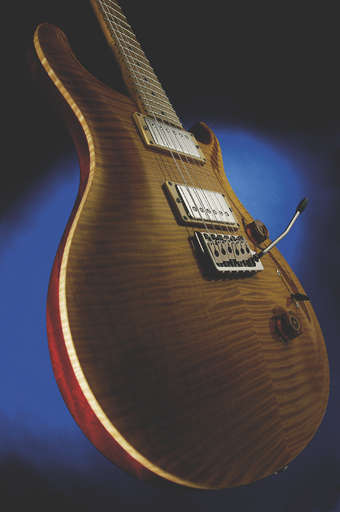MusicRadar Verdict
If you thought PRS guitars were just full of thick Gibbo-like tone plug this in. Thanks to Mr Hiland, Fender could be checking this baby´s legality.
Pros
- +
The combination of subtle changes to create a superb new flavour
Cons
- -
Positioning of the three-way lever may bother some PRS fans
MusicRadar's got your back




Few guitarists enjoy as much respect as Johnny Hiland, and if you´ve ever been lucky enough to see him in action you´ll know why. His perma-Stetson suggests a country twangster but, while Hiland has his super-Nashville chops down pat, he´ll suddenly rip into metal meltdown, Gatton-esque jazz, blues, you name it: he´ll play it.
He´s the archetypal stunt guitarist and makes it all look effortless. You won´t see him break sweat and if indeed he has an ego he leaves it well hidden. He´s certainly a world away from PRS´s other high profile signature artists, lacking the huge-selling credentials of Carlos Santana or the modern rock kudos of Mark Tremonti, Dave Navarro and new-for-2007 signature artist Chris Henderson of 3 Doors Down. But arguably Hiland´s signature model is the most interesting artist guitar that PRS has ever created and - for PRS fact-lovers - it is also the first-ever artist bolt-on model.
The JH is unique to the PRS line. The only current maple ‘boarded bolt-on is the Swamp Ash Special, but that´s a 22-fretter where the JH is a 24-fret guitar. Unlike the SAS it uses the typical PRS body recipe of one-piece mahogany back with carved maple top (the SAS uses ash). Its closest relative then is the CE Maple Top 24 (and it comes with a CE prefix to the serial number engraved on the neck plate) but you can´t get that with a maple ´board and, when you could back in the late eighties, it came with an alder body back.
But there´s plenty more uniqueness to this model: it´s the only PRS guitar to use a three-way Fender-style lever pickup selector, then there are its large black dot fretboard markers - just under 9mm in diameter below the 12th fret and closer to 7mm above - that come with a 513-style 12th fret bird inlay (there´s even a first fret dot - a tribute from Johnny to the late Danny Gatton). It has its own JH neck carve too, along with specially created JH Treble and Bass covered humbuckers. Even the ‘Johnny Hiland´ engraved truss rod cover is inlaid into the headstock to facilitate those behind-the-nut bends.
Yet such is the visual strength of the now-classic double-cutaway outline, headstock and dual humbucker/vibrato layout, not to mention the beautiful ‘fiddleback´ flamed maple 10 top, that it couldn´t be anything else but a PRS.
In use
PRS makes very, very good guitars. Opening the case, it´s as near-as-dammit in tune. The set-up is bang-on PRS specification. It doesn´t need tweaking or adjustment - so long as you use the supplied .009-.042 strings, of course - and it´s gig ready.
Want all the hottest music and gear news, reviews, deals, features and more, direct to your inbox? Sign up here.
On a tactile level the main change here to the PRS blend is the neck. PRS describes the Johnny Hiland neck carve as, “a variation of a PRS wide-thin neck, incorporating aspects of a ‘C´-style neck from the first fret to the 12th fret”. In the hand the nitro, low gloss-finish neck feels like a slightly deeper wide-thin, even though it doesn´t feel that wide at all, perhaps due to the fuller profile.
Typically the edges are subtly rounded and the fretwork, from PRS´s standard gauge, is smooth and high enough for fast hammer-ons, pull-offs and bends. Typically PRS uses quarter-sawn timber for its necks. Fender bolt-on necks, and the majority of others, are slab-sawn and, aside from the theoretical additional stiffness of this selection, you´ll see the figuring and grain flecking on the back of the neck rather than the side as you would with a slab-sawn neck. It´s not highly figured but there´s subtle interest here.
On models like the Swamp Ash Special (and early CE maple necks) PRS uses abalone dots or optional birds for position markers and light coloured side dots that were nickel silver, until late 1999, when they changed to Delrin plastic. The problem is that these low-contrast dots can easily ‘disappear´ against the maple - usually onstage just before your big solo!
Also, until early 2005, PRS only used a single 12th fret side dot; thankfully they now use two. Hiland, who in USA terms is legally blind though he has partial sight, has at last made the company see (pardon the pun) some sense and use proper contrasting black dots. Ironic really, because even with Hiland´s restricted vision you get the sense he could play note perfect in the dark with a bag over his head.
As for the Hiland humbuckers, PRS tells us that the bridge-placed Treble pickup “is a cross between a clear McCarty Treble pickup and an over-wound ‘Country Style´ single-coil,” and that the neck-placed Bass humbucker “is a powerful and clear pickup with lively vintage characteristics.” The controls are placed in the same position as the Swamp Ash Special, slightly different to the usual PRS layout. The volume is in the normal PRS position but the tone and pickup selector are reversed, which takes a little adjustment if you play, for example, a Custom. The pull/push switch on the tone control splits just the Bass humbucker - not both humbuckers - voicing the neck-facing single coil.
Sounds
Firing up our trusty test amps and the JH had us scratching our heads. Here´s a guitar that you´d think should be Tele-tastic but the bridge pickup is cranking out one of the finest southern-fried rock tones we´ve ever heard. Mr Gibbons, eat that. The neck pickup seemed a little underpowered until we realised, by spec, that with the pull/push down it´s just the single-coil and you pull it up to voice the full coil - the reverse of PRS´s, and most others´, usual set-up.
Soon you realise that in this down ‘default´ position you have a great Texas-type rhythm tone with both pickups selected; turn the volume down and it gets more Fendery and the neck single-coil alone is superbly tuneful and bell-like.
In fact, switch your amplifier to a more country-style cleaner tone and you´d swear it´s a Fender guitar you´re hearing. But even in these cleaner settings the bridge pickup stamps its authority on the sound: it wants to scream but it doesn´t sound over bright. Turn down the volume a little and again a more hot-Tele tone, or P90-like voice, is revealed. It´s great for pinched harmonics and Buchanan-like squeals.
Turn the tone control down a little and a smoother, jazzier voice emerges; crank the amp back up and those Claptonesque ‘woman tones´ are in place or, with the tone turned back up, a more creamy, vocal PRS signature tone but with the added edge and texture of the maple bolt-on.
MusicRadar is the number 1 website for music makers of all kinds, be they guitarists, drummers, keyboard players, djs or producers...
GEAR: We help musicians find the best gear with top-ranking gear round-ups and high- quality, authoritative reviews by a wide team of highly experienced experts.
TIPS: We also provide tuition, from bite-sized tips to advanced work-outs and guidance from recognised musicians and stars.
STARS: We talk to musicians and stars about their creative processes, and the nuts and bolts of their gear and technique. We give fans an insight into the actual craft of music making that no other music website can.
